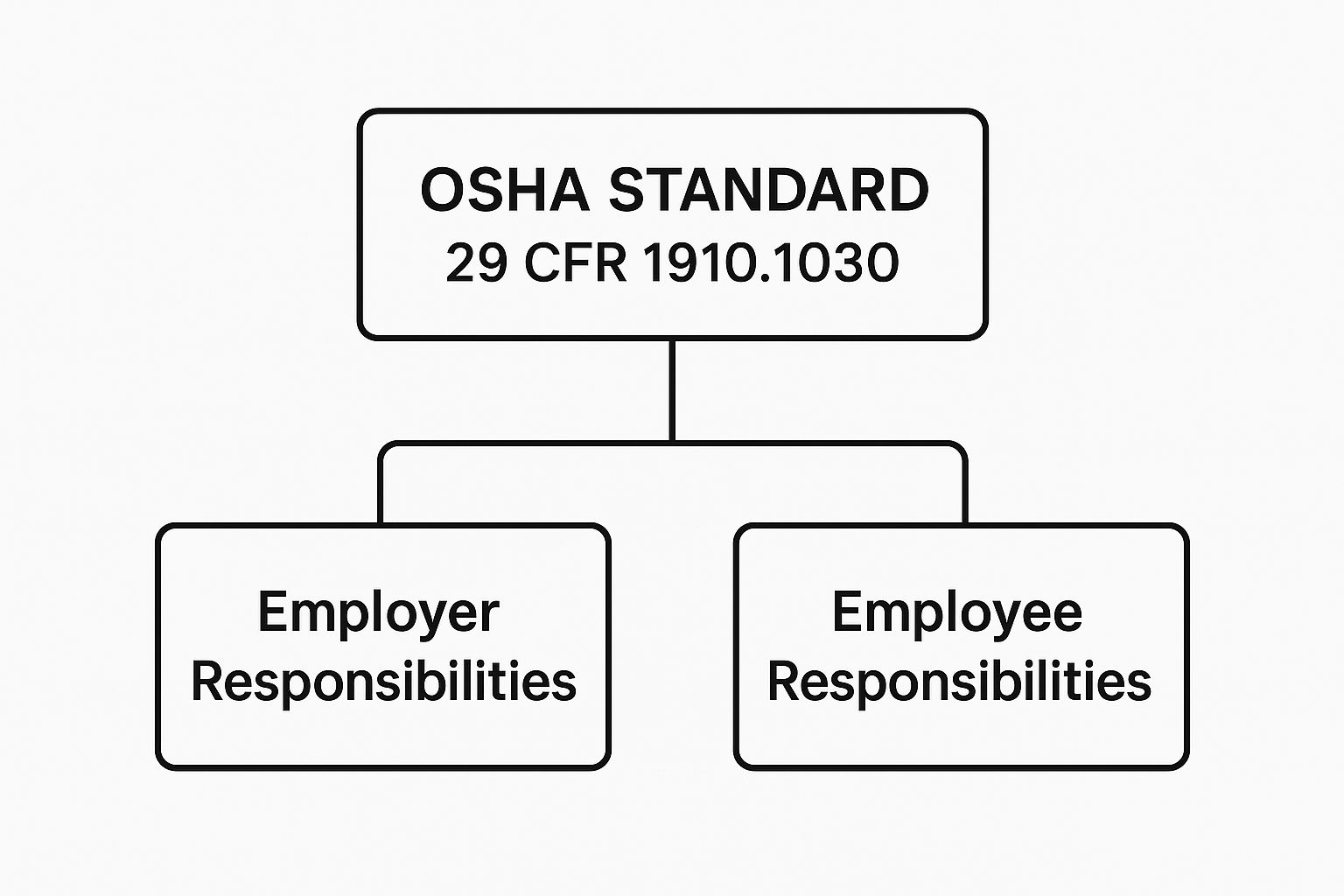Navigating the rules for bloodborne pathogens training can feel a bit overwhelming at first. But the core idea is pretty simple: if any of your employees could reasonably come into contact with blood or other potentially infectious materials (OPIM) as part of their job, they need to be trained. This isn't just a suggestion—it's a federal requirement from OSHA designed to keep your team safe from some very serious health risks.
Understanding OSHA's BBP Training Standard

The Occupational Safety and Health Administration's (OSHA) Bloodborne Pathogens (BBP) Standard isn't just a boring stack of regulations. It's better to think of it as a blueprint for keeping your workplace safe from invisible threats like HIV, Hepatitis B (HBV), and Hepatitis C (HCV). These are nasty viruses that can cause lifelong illness, and the standard gives employers a clear roadmap to minimize that danger.
The whole thing hinges on one key phrase: "occupational exposure." This just means any time an employee's skin, eyes, or mucous membranes might touch blood or OPIM while they're on the clock. It also covers "parenteral" contact, which is a fancy term for a needlestick or cut. If that sounds like even a remote possibility for anyone on your staff, then this training is a non-negotiable must.
Why This Standard Is So Important
The BBP standard is about way more than just checking a box to dodge fines. It’s about creating a real culture of safety where every single person on your team feels prepared and protected. When people get the risks and know exactly what to do, they're empowered to protect themselves and their coworkers.
This kind of proactive training is always a better bet than reacting after an exposure has already happened. It’s why the law demands that employers provide training when someone is first hired, at least once a year after that, and anytime a job changes in a way that introduces new exposure risks.
The Foundation of Workplace Safety
Getting a firm grip on this standard is step one. It's the "why" behind everything else, from writing an Exposure Control Plan to providing the right personal protective equipment (PPE). When you understand the mission, you can build a program that doesn't just meet the legal requirements—it actually works.
Proper training hands your team the critical knowledge they need to stay safe. This includes:
- Understanding the Dangers: Knowing which diseases can be transmitted through blood and OPIM.
- Spotting the Risks: Identifying which tasks and situations could lead to an exposure.
- Using Protective Gear: Learning how to properly use PPE and follow safe work practices.
- Handling Emergencies: Knowing what steps to take immediately after an exposure incident happens.
By building this foundation of knowledge, you’re making a real investment in the health and well-being of your most important asset—your people. You can dive deeper with our complete guide to bloodborne pathogens training and see how it helps foster a safer work environment for everyone.
Who Actually Needs Bloodborne Pathogens Training?
When you hear "bloodborne pathogens training," your mind probably jumps straight to doctors and nurses. But OSHA’s rules on this are much broader than you'd think. It’s not really about job titles at all. The real question is: could an employee's job reasonably put them in contact with blood or other potentially infectious materials (OPIM)?
If the answer is yes, then training isn't just a smart move—it's a legal requirement. This pulls in a surprising number of professions you might not expect. We’re talking about everyone from tattoo artists and school janitors to plumbers and hotel housekeepers. Each of these roles has its own unique risk of occupational exposure, and that makes solid training an absolute necessity.
The image below breaks down the clear chain of responsibility under the OSHA standard.

As you can see, creating a safe workplace is a team effort. Employers are on the hook for putting the safety plan in place, and employees are responsible for following it.
High-Risk and Unexpected Professions
The list of jobs covered by OSHA's BBP standard is surprisingly long. Of course, some environments come with obvious, high-level risks, like those that need specialized medical office cleaning services. But plenty of other roles have more subtle risks that are just as serious.
Think about these often-overlooked jobs:
- Custodial Staff: Cleaning a public restroom or a school locker room could easily involve handling an improperly discarded needle or cleaning up blood after an accident.
- School Personnel: Teachers, coaches, and school nurses are constantly dealing with playground scrapes, bloody noses, and sports injuries.
- Tattoo and Piercing Artists: Their entire job revolves around intentionally breaking the skin, putting them at direct and constant risk of blood exposure.
- Plumbers and Maintenance Workers: These pros can run into blood or OPIM when fixing pipes in a clinic or dealing with a messy sewage backup.
OSHA’s definition of occupational exposure is intentionally broad. It’s designed to protect anyone whose work duties create a reasonable anticipation of contact with blood or OPIM, regardless of their official job title.
The scale here is massive. The CDC estimates that about 18 million healthcare workers are at risk. But that number balloons when you add the more than 109 million home health aides, childcare workers, and other service professionals. And that's not even counting the nearly two million law enforcement officers and firefighters who run toward emergencies every single day.
Categorizing Risk Across Industries
To really get a handle on your responsibilities, it helps to see how these risks break down across different sectors. A detailed guide, like our OSHA compliance checklist, can make a world of difference in clarifying what you need to do.
Let's look at some key industries and the specific exposure risks they face.
Industries Requiring BBP Training Under OSHA
This table shows that BBP training isn't just for a select few. It’s a critical safety measure for a wide range of professionals who help keep our communities running safely.
Core Elements of a Compliant Training Program
So, what exactly needs to be in a training program to satisfy OSHA's bloodborne pathogens training requirements? It’s far more than just sitting through a quick video and checking a box. A truly compliant and effective program is a complete educational experience, built to give your team practical, life-saving knowledge.
Think of it like building a safety toolkit. Each part of the training is a specific tool your employees will need to handle real-world situations with confidence. OSHA is very clear about what goes into this toolkit; they don't leave it up to guesswork.
The Essential Training Curriculum
A program simply isn't compliant if it's missing any of the required pieces. It has to be a complete package that covers every angle of BBP safety. The training must also be delivered in a way that’s easy for everyone to understand, no matter their background or education level.
Your training absolutely must cover:
- The BBP Standard Explained: Employees need access to a copy of the OSHA standard (29 CFR 1910.1030), and the training should break down its key parts in plain English.
- Understanding BBP Diseases: A clear rundown of the basics—epidemiology and symptoms—of common bloodborne diseases, especially HIV, Hepatitis B (HBV), and Hepatitis C (HCV).
- How Transmission Occurs: Simple, direct explanations of how these pathogens can spread from one person to another in your specific work environment.
- Your Company's ECP: A detailed walkthrough of your workplace's specific Exposure Control Plan (ECP). This includes telling employees exactly where to find it and how it applies to their daily jobs.
That last point is a big one. Generic, one-size-fits-all training just doesn’t cut it. The program has to be customized for your facility, addressing the unique tasks and risks your team faces.
Practical Skills and Safety Protocols
Beyond just theory, the training has to give employees hands-on skills and clear steps to follow. This is where the training shifts from the "what" to the "how." A huge part of this is a solid understanding of staying safe on the job, which includes choosing personal protective gear that's right for specific tasks and potential exposures.
Key practical elements include:
- Methods of Compliance: A thorough explanation of the safety measures you have in place. This means covering Universal Precautions, engineering controls (like your sharps disposal containers), and safe work practices.
- Personal Protective Equipment (PPE): Training on the different types of PPE available, where to get them, how to use them correctly, and the right way to dispose of them.
- Hepatitis B Vaccine: Information on the HBV vaccine, including its safety, effectiveness, and the critical fact that it must be offered free of charge to employees with occupational exposure.
- Emergency Procedures: Clear, step-by-step instructions for what to do if an exposure incident happens. This includes how to report it and the post-exposure evaluation and follow-up process that will be provided. These protocols often tie into general workplace safety, much like those in our guide to OSHA first aid requirements.
The Most Important Component: The Interactive Q&A
Now for the detail that trips up a lot of online-only programs. OSHA requires that the training must include a chance for an interactive question-and-answer session with the person leading the training. This is absolutely non-negotiable.
OSHA Standard 1910.1030(g)(2)(vii)(N) explicitly requires that the trainer be "knowledgeable in the subject matter" and available to answer questions during the training session.
What does this mean in practice? A pre-recorded video that just provides an email address for questions doesn't meet the standard. Your team has to be able to ask specific questions about their unique job duties and get immediate, expert answers. It’s the only way to be certain they fully grasp how to apply the training to their personal work environment.
Without this live, interactive piece, a BBP training program is not compliant. Period.
How Often Your Team Needs Training and How to Document It

Meeting bloodborne pathogens training requirements isn’t a one-and-done task. It’s easy to think of it as a box to check, but it’s much more like a continuous subscription to safety. OSHA compliance is an ongoing commitment, and the rules for training frequency are there to make sure your team's knowledge never gets stale.
After all, the risks don't just vanish after the first training session. A major global review found that the lifetime risk of occupational exposure to blood and body fluids for healthcare workers is a staggering 56.6%. The persistence of these risks is exactly why regular training is so critical for protecting your staff. You can read the full study on global occupational exposure statistics for a deeper look.
So, how often does your team really need to sit down for this training? The answer is more specific than you might think.
The Three Triggers for BBP Training
OSHA is very clear about when training must happen. Forgetting even one of these triggers can put you out of compliance just as easily as skipping the training altogether.
Your team needs BBP training at three distinct times:
- Upon Initial Assignment: Every new hire whose job involves occupational exposure must be trained before they start any task that carries a risk. This gives them the foundational knowledge to work safely from day one.
- At Least Annually: After that first session, every employee must get refresher training at least once a year. This keeps their skills sharp and brings them up to speed on any new procedures or policies.
- When Job Tasks Change: If an employee's duties are modified or a new hazardous task is introduced, they need more training. This session must cover the specific new risks tied to their updated role.
An annual refresher isn't just a friendly suggestion; it’s a hard requirement. The one-year mark is calculated from the date of the last training, so keeping meticulous records is the key to staying on schedule and proving compliance.
This regular cycle of training and retraining is fundamental. It ensures safety protocols stay top-of-mind and that your team is always prepared for the latest workplace hazards. Understanding the full scope of workplace safety regulations can be complex, but our guide on OSHA safety training requirements provides a broader look at how these rules fit together.
Mastering Your Documentation
If you can't prove you did the training, it’s as if it never happened in the eyes of an OSHA inspector. Proper documentation is your armor against citations and fines. Your training records must be organized, detailed, and easy to find when you need them.
Your records for each training session must include:
- The dates of the training session.
- A summary of the contents of the training program.
- The names and qualifications of the person(s) conducting the training.
- The names and job titles of all persons who attended.
These records aren't just for your files. OSHA requires you to keep them for at least three years from the date the training occurred. This creates a clear, defensible history of your commitment to safety, proving you’ve met all legal bloodborne pathogens training requirements consistently over time.
Building Your Workplace Exposure Control Plan
If OSHA's Bloodborne Pathogens standard is the "why" behind workplace safety, your Exposure Control Plan (ECP) is the "how." This isn't just another document you create to file away and forget. You should think of your ECP as the operational heart of your entire safety strategy—a living, breathing blueprint that spells out exactly how you protect your employees every single day.
Just like a fire escape plan has to be specific to a building, a generic, one-size-fits-all ECP simply won't work. Your plan must address the unique tasks, procedures, and risks your team actually faces, turning abstract safety rules into concrete, actionable steps. Without a detailed and current ECP, your safety program is fundamentally incomplete.
Core Components of a Strong ECP
OSHA requires every ECP to be a written document that's easily accessible to all employees. It’s the central reference guide for your entire safety protocol. To stay compliant, your plan needs to include several key elements that work together to create a solid, cohesive safety system.
Your ECP must contain:
- The Exposure Determination List: This is a critical first step. You must identify all job classifications where employees have occupational exposure and then list the specific tasks and procedures where that exposure might happen.
- Implementation Methods: This section gets into the nitty-gritty. It details the specific measures you use to cut down on risk, including universal precautions, engineering controls (like sharps containers), and safe work practices (like proper handwashing).
- Hepatitis B Vaccination Policy: Your plan has to clearly outline the process for offering the Hepatitis B vaccine series—free of charge—to all employees with occupational exposure. It also needs to cover the procedure for handling vaccination declination forms.
- Post-Exposure Evaluation and Follow-Up: This is your emergency action plan. It must lay out the exact steps an employee needs to take after an exposure incident, how to report it, and the confidential medical evaluation and follow-up you will provide.
- Communication of Hazards: This covers your system for using labels and signs to identify biohazards, making sure everyone is aware of potentially contaminated materials or areas.
- Recordkeeping: Your ECP should specify how you maintain training records and confidential medical records related to BBP safety, ensuring they are kept for the required amount of time.
The Annual Review and Employee Involvement
An ECP isn't a "set it and forget it" document. OSHA mandates that you must review and update the plan at least annually and whenever new or modified tasks or procedures change the risk of occupational exposure. This annual review is your chance to see what’s working, what isn’t, and how you can improve.
Critically, this review process isn't meant to happen behind closed doors.
OSHA’s standard is clear: employers must solicit input from non-managerial, frontline employees who are responsible for direct patient care or are potentially exposed to injuries from contaminated sharps.
This requirement is a real game-changer. It forces the plan to stay practical and effective by bringing in feedback from the very people who face the risks every day. They are in the best position to flag real-world challenges and suggest safer medical devices or work practices. For example, a phlebotomist might recommend a new type of safety-engineered needle that has made their job both safer and more efficient. In an emergency, being familiar with these protocols can be just as vital as knowing how to use a tourniquet, a key skill covered in Stop the Bleed training.
When you involve your team, you don't just improve the ECP—you build a stronger culture of safety where everyone feels heard and valued. This collaborative approach turns a simple compliance document into a powerful tool for genuine workplace protection.
Choosing the Right BBP Training for Your Team

Knowing the regulations is only half the battle. The other half is finding a training partner who can turn those OSHA requirements into genuine, real-world skills for your team.
You’ll find a ton of options out there, from quick online videos to full-day, in-person workshops. It can be tough to sort through it all. The key is to look past the sales pitch and find a provider that delivers real value, not just a flimsy certificate.
Remember, the goal isn't just to check a box for OSHA. It's to give your people the confidence and skills they need to handle a potentially life-altering situation without panicking. The right program makes all the difference between someone who just knows the rules and someone who is truly prepared.
Evaluating Training Providers
Let's be clear: not all BBP training is created equal. A program might look compliant on paper but completely lack the depth and interaction needed for the information to actually stick. When you're looking at different providers, you need a solid checklist to make sure you're getting a quality education that meets all bloodborne pathogens training requirements.
Start by looking for these absolute must-haves:
- Expert Instructors: Who is actually teaching the class? Look for trainers with real-world experience in healthcare or emergency response, like nurses, paramedics, or EMTs. Their firsthand knowledge is what helps answer those tricky, site-specific questions that always come up.
- Comprehensive Curriculum: Does the course explicitly cover every single topic mandated by the OSHA standard? Don't be shy about asking for a detailed course outline and comparing it directly against the regulations.
- Interactive Q&A: This is a non-negotiable. The program absolutely must include a live, interactive portion where employees can ask questions and get immediate answers from a qualified trainer. A simple email address for follow-up questions doesn't cut it and won't satisfy this critical OSHA requirement.
Choosing the Best Format for Your Workplace
Next, you have to decide on the right format. While online-only courses offer a lot of convenience, they almost always fall short on that crucial interactive component. In-person training, on the other hand, creates a dynamic learning environment where your team can engage directly with the instructor and each other.
The most effective training often blends convenience with hands-on practice. A hybrid model, combining online pre-work with an in-person skills session, can be an excellent way to cover all the bases efficiently while ensuring genuine understanding.
Think about what will work best for your team's schedule and how they learn. A hands-on session where employees can physically handle PPE and practice spill cleanup procedures builds a level of muscle memory that a video simply cannot replicate.
At Ready Response, this is exactly the approach we specialize in. Our instructors are experienced professionals—nurses, paramedics, and first responders—who bring the material to life with practical, real-world insights. We structure our BBP training to be fully interactive and engaging, ensuring your team isn’t just sitting through a lecture but actively participating in their own learning. Our on-site group courses bring expert-led, hands-on training directly to your facility, tailored to your specific workplace hazards.
With Ready Response, you can be certain your team is not just compliant, but genuinely prepared and confident.
Frequently Asked Questions About BBP Training
Even after you get a handle on the OSHA rules, specific questions always seem to pop up. Let's walk through some of the most common ones we hear from businesses trying to get their bloodborne pathogens training just right.
Is Online-Only BBP Training Compliant?
This is a big one, and the short answer is: rarely. While online modules can be a fantastic part of your training program, they almost never satisfy the full OSHA requirement on their own.
OSHA is crystal clear on this point: all BBP training must include a live Q&A session with a qualified trainer. A pre-recorded video or a simple quiz just doesn't cut it. Your team needs the ability to ask site-specific questions and get immediate, knowledgeable answers from a real person.
What If an Employee Declines the Hepatitis B Vaccine?
You can’t force an employee with occupational exposure to get the Hepatitis B shot if they choose not to. But you do have a critical documentation step to follow.
You must have the employee sign an official OSHA declination form. This is a formal record confirming they were offered the vaccine at no cost but decided against it.
It's important to remember that this decision isn't final. You must still make the vaccine available to them, free of charge, if they change their mind and decide to get it later.
Filing this signed form in the employee’s medical records is a non-negotiable part of staying compliant.
How Long Must We Keep Training Records?
Your paperwork is your proof of compliance. According to OSHA standard 29 CFR 1910.1030(h)(2), you are required to hold on to BBP training records for at least three years from the date of the training.
These records need to be detailed and must include:
- The dates the training took place.
- A summary of the curriculum and topics covered.
- The names and qualifications of your trainers.
- The names and job titles of every employee who attended.
You also need to have these records ready to show to employees or OSHA representatives upon request. Staying organized here is the key to proving you have a consistent and effective safety program in place.
At Ready Response, we make sure every piece of our training—from the course content to our instructors—meets and exceeds OSHA's strict standards. We focus on building confident, prepared teams through engaging, hands-on courses that prioritize real understanding over just checking a box. Visit us at https://readyresponsepa.com to see how our expert-led programs can strengthen your workplace safety.
